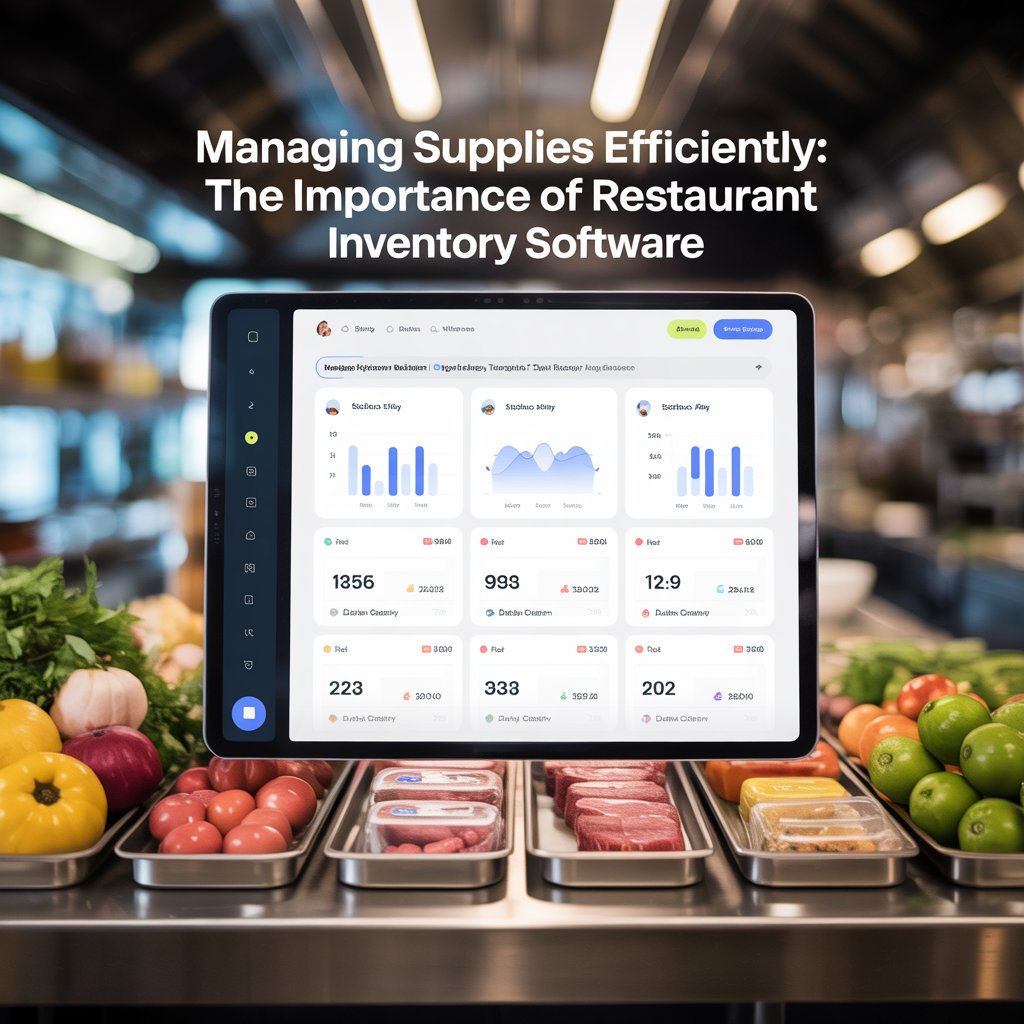Running a successful restaurant involves much more than just serving delicious food. Behind the scenes, restaurant managers and owners must keep track of ingredients, manage stock levels, and ensure a seamless supply chain to avoid food waste and unexpected shortages. Restaurant inventory software simplifies this process by automating inventory tracking, reducing errors, and improving operational efficiency.
Without a proper inventory system, restaurants face issues like stock shortages, over-ordering, increased costs, and even health code violations due to expired ingredients. This is why more restaurants are turning to digital solutions to manage supplies efficiently.
By the end of this guide, you’ll have a clear understanding of why investing in restaurant inventory software is a smart move for any food business.
The Challenges of Manual Inventory Management
Many restaurants still rely on traditional inventory management methods, such as spreadsheets, handwritten records, or even visual inspections. While this might work for small-scale operations, it often leads to inefficiencies as the business grows.
Here are some common challenges of manual inventory tracking:
1. Human Errors and Inconsistencies
Manually updating spreadsheets leaves room for mistakes. A small miscalculation can lead to incorrect orders, causing shortages or overstocking.
2. Time-Consuming Process
Restaurant staff spend hours counting and recording stock levels instead of focusing on customer service and food preparation.
3. Lack of Real-Time Updates
With manual tracking, stock levels are updated only when someone records the changes. This creates delays and makes it difficult to get accurate, up-to-date inventory data.
4. Food Waste Due to Expired Ingredients
Without automated expiration tracking, restaurants often forget to use ingredients before they expire, leading to unnecessary waste and loss of revenue.
5. Inefficient Ordering Process
Ordering supplies manually without tracking actual stock usage can result in over-ordering, leading to waste, or under-ordering, causing menu disruptions.
These inefficiencies impact a restaurant’s profitability, making inventory management software an essential tool for modern food businesses.
How Restaurant Inventory Software Works
Restaurant inventory software automates the entire inventory process, reducing manual errors and improving efficiency. Here’s how it typically works:
1. Tracking Ingredient Usage
Every time a dish is sold, the software automatically deducts the corresponding ingredient amounts from the inventory.
2. Real-Time Stock Updates
Managers can view real-time stock levels, ensuring they never run out of essential ingredients.
3. Automated Reordering
The software generates purchase orders when stock levels reach a pre-set threshold, ensuring a steady supply of ingredients.
4. Expiry Date Management
Alerts notify staff when ingredients are approaching their expiration dates, reducing waste.
5. Cost Control and Analytics
Advanced software provides detailed reports on inventory costs, waste, and profitability, helping restaurants optimize spending.
By automating these processes, restaurant inventory software reduces workload, minimizes waste, and increases profitability.
Key Features of Restaurant Inventory Software
Not all inventory management systems are the same. The best restaurant inventory software should have the following features:
- Cloud-Based Access – Allows managers to check inventory levels remotely from any device, making multi-location management easier.
- Integration with POS Systems – Seamlessly connects with the restaurant’s point-of-sale system to automatically track inventory changes based on sales.
- Barcode and QR Code Scanning – Enables staff to scan items for quick and accurate stock updates.
- Automated Low-Stock Alerts – Sends notifications when ingredients are running low, ensuring timely reordering.
- Supplier Management – Tracks supplier details, past orders, and pricing trends for better cost negotiations.
- Waste Tracking – Monitors how much food is wasted and identifies patterns to reduce losses.
- Recipe Costing and Menu Engineering – Calculates the cost of each dish based on ingredient prices, helping managers adjust menu pricing for better profitability.
- Multi-Location Support – For restaurant chains, the software syncs inventory across all locations for centralized stock management.
Choosing software with these features will ensure maximum efficiency and cost savings for any restaurant.
The Key Benefits of Restaurant Inventory Software
Managing inventory manually is time-consuming and prone to costly errors. Restaurant inventory software simplifies operations, reduces waste, and improves profitability. Here’s how it benefits your business:
1. Minimizes Food Waste & Prevents Overstocking
Problem: Ingredients expire before use, leading to waste.
Solution: Automated tracking alerts you before expiration, applies FIFO (First-In, First-Out) stock rotation, and prevents over-purchasing.
2. Cuts Costs & Maximizes Profit Margins
Problem: Uncontrolled ingredient costs and frequent last-minute purchases.
Solution: Tracks food costs in real time, adjusts orders based on usage trends, and highlights cost-effective suppliers.
3. Saves Time & Automates Stock Management
Problem: Manual stock counting is slow and prone to errors.
Solution: Integrates with POS systems for automatic updates, provides real-time tracking, and enables barcode/QR code scanning for quick checks.
4. Improves Supplier Management & Ordering Efficiency
Problem: Missed orders, pricing inconsistencies, and unreliable vendors.
Solution: Centralized supplier database, automated reordering, and pricing comparison tools to secure the best deals.
5. Enhances Menu Consistency & Customer Satisfaction
Problem: Running out of key ingredients leads to inconsistent dishes.
Solution: Ensures ingredient availability, maintains portion control, and tracks high-demand menu items.
6. Provides Data-Driven Insights for Smarter Decisions
Problem: No clear visibility on food costs, waste, or menu performance.
Solution: Generates detailed reports on ingredient usage, sales trends, and profit margins to optimize menu pricing.
How to Choose the Right Restaurant Inventory Software?
Selecting the right restaurant inventory software is a critical decision that can significantly impact your business’s efficiency, cost savings, and overall success. With so many options available, choosing the best system for your restaurant requires careful consideration of several factors. Below is a detailed guide to help you make the best choice.
1. Ease of Use: User-Friendly Interface and Accessibility
The software should be intuitive and easy to navigate, allowing your team to adopt it quickly without extensive training. If the system is too complex, it may lead to errors or resistance from staff, defeating the purpose of automation.
What to look for:
- A simple, clean dashboard with clear menus and options.
- Drag-and-drop features for managing inventory items.
- A mobile-friendly version or an app for easy access.
- Role-based access control to ensure employees see only what they need.
Tip: Look for software with a demo or free trial to test its usability before committing.
2. Integration Capabilities: Syncing with POS and Other Systems
Your inventory software should seamlessly integrate with your existing point-of-sale (POS) system, accounting software, and supplier databases to provide real-time updates on stock levels and sales. Without proper integration, you may still need manual data entry, increasing the risk of errors.
What to look for:
- POS System Integration – Ensures that every sale automatically updates inventory counts.
- Accounting Software Compatibility – Syncs financial records for better cost tracking.
- Supplier Management Integration – Connects directly to vendor portals for easy reordering.
- Cloud-Based Access – Enables remote management and multi-location syncing.
Tip: Check with your current POS provider to see if they offer built-in inventory solutions or have compatible third-party software options.
3. Scalability: Will It Grow with Your Business?
If you plan to expand your restaurant, whether by adding new locations or increasing menu items, your software should be scalable. Investing in a system that can grow with your business prevents the hassle of switching to new software later.
What to look for:
- Multi-location support if you own or plan to open multiple restaurants.
- The ability to handle large inventories without slowing down.
- Customizable features to match your evolving needs.
Tip: Choose a system that allows easy upgrades so you don’t have to switch platforms as your business grows.
4. Cost and ROI: Finding the Best Value for Your Budget
While cost is a key factor, the cheapest software may not always be the best option. Consider both the initial investment and the long-term return on investment (ROI).
What to look for:
- Subscription Plans vs. One-Time Fees – Some software charges a monthly fee, while others require a one-time purchase.
- Hidden Costs – Check for additional fees for integrations, user limits, or software updates.
- Feature-Based Pricing – Some platforms charge more for advanced features like AI-based forecasting.
- Trial Periods – Many companies offer free trials or demos to test functionality before committing.
Tip: Instead of focusing solely on price, evaluate how much time and money the software can save your restaurant through automation, waste reduction, and improved efficiency.
5. Customer Support and Training: Ensuring Smooth Implementation
No matter how intuitive software is, your team may need assistance in setting it up or troubleshooting issues. Reliable customer support is essential for minimizing downtime and ensuring smooth daily operations.
What to look for:
- 24/7 support availability – Essential for restaurants that operate late hours or 24/7.
- Live chat, phone, and email support – Multiple support channels for quick assistance.
- Training resources – Look for video tutorials, user manuals, and FAQs.
- Onboarding assistance – Some providers offer hands-on training to help with setup.
Tip: Read online reviews to see how responsive and helpful a provider’s support team is before purchasing.
Best Practices for Implementing Inventory Software
Once you’ve chosen the right inventory software, follow these steps to ensure successful implementation:
- Train Your Staff – Conduct proper training sessions to help employees understand how to use the software.
- Start with a Trial Run – Test the system with a few key items before a full-scale rollout.
- Customize Settings – Adjust features like low-stock alerts and automated ordering to fit your restaurant’s needs.
- Regularly Update Data – Keep ingredient prices and supplier details updated for accurate reports.
- Monitor Performance – Use the software’s analytics tools to track cost savings and efficiency improvements.
Conclusion
Restaurant inventory software is a game-changer for businesses looking to optimize operations, reduce costs, and improve efficiency. By automating stock tracking, managing supplier relationships, and minimizing food waste, restaurants can boost profitability and enhance customer satisfaction.
If you’re still relying on manual inventory tracking, now is the time to upgrade. Investing in the right inventory software can streamline your restaurant’s operations and set you up for long-term success!
Ready to take control of your restaurant’s inventory? Explore top inventory management solutions today and watch your business thrive!





























